The technology that could end traffic jams
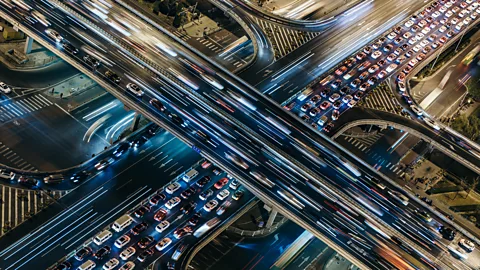 Getty Images
Getty ImagesWith the number of cars clogging roads around the world expected to double in the coming decades, new ways of responding to crashes, controlling traffic lights and creating diversions will be needed to keep traffic moving.
We’ve all been there. Stuck at traffic lights that never seem to change to green. Sitting in queues of cars that stretch on for miles or delayed by a glut of slow traffic that suddenly disappears. Traffic jams are a blight on our modern, fast moving lives. And we have been dealing with them in a very unmodern way.
We don’t move about and travel in the same way that we used to, yet our traffic management systems have struggled to keep pace with the relentless onslaught of vehicles they have to deal with now. Jam-busting measures are often slow to react to changes in road or weather conditions and many traffic lights still work on timers that are often out of synchronisation, preventing vehicles from flowing freely.
You might also like:
• The chef making 120 burgers every hour
In 2015 there were an estimated 1.3 billion motor vehicles on the world’s roads and with growing affluence in developing economies that number is expected to soar to over 2 billion by 2040. Even with new roads and byes, this ever increasing level of traffic could quickly outstrip the ability of our road networks to cope in many busy areas, such as cities.
But by combining new communications technology with the power of artificial intelligence (AI) to crunch vast amounts of data in real time it may be possible to ease our clogged roads so they can cope with the growing number of cars.
While many see self-driving vehicles as the panacea for traffic jams – provided these robotic vehicles can be taught to drive less erratically and react faster than human motorists – it will be at least two decades before they start to make a meaningful impact on our roads. In the meantime, highways agencies and city planners will have to cope with an ever-more complicated mix of human, semi-autonomous and autonomous drivers on the roads. Keeping them all moving will require traffic management systems to be instantly reactive and adaptable.
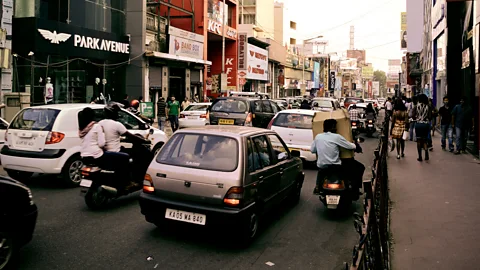 Getty Images
Getty ImagesIn Bengaluru, India, which regularly faces long traffic jams and the average speed on some roads at peak hours is just 4km/h (2.5mph), Siemens Mobility has built a prototype monitoring system that that uses AI through traffic cameras. Traffic cameras automatically detect vehicles and this information is sent back to a central control centre where algorithms estimate the density of traffic on the road. The system then alters the traffic lights based on real-time road congestions.
To respond in this way, however, requires data. A lot of data. Fortunately, this is not something in short supply. There’s lots of information from traffic monitoring systems, road infrastructure, cars and drivers themselves via their mobile phones. Millions of cameras line our roads while the ing vehicles induces tiny electrical currents in loops of metal hidden beneath the tarmac, providing further information about the traffic conditions. Motorists can send instant updates about hold ups thanks to the navigation software they use on their mobile phones and in their cars.
Some of this monitoring technology – like the induction loops – have been around since the 1960s while others like cameras capable of tracking traffic and reading number plates are more recent. The challenge is doing something useful with all this information.
“Since Isaac Newton we have been trying to influence the world by building mathematical models,” says Gabor Orosz, an associate professor in engineering at the University of Michigan. “If we have data we can figure things out. The same applies to traffic.”
There are now attempts to harness AI’s ability to make sense of large amounts of information and change the way that we move around our cities.
Researchers at The Alan Turing Institute in London and the Toyota Mobility Foundation recently launched a new project together that is exploring how traffic management systems can become more dynamic and responsive through the use of AI. They are currently using simulations that scale up in complexity and evolve, helping their algorithms to learn how to predict changes in the traffic. Although they are still testing the system, they hope to soon apply their systems in the real world.
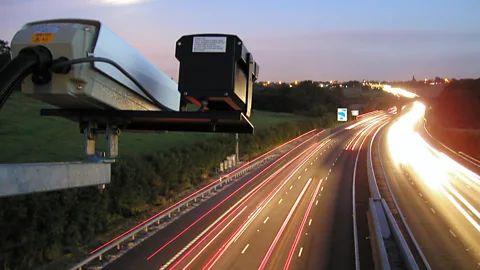 Getty Images
Getty Images“With deep machine learning we can improve predictability,” says William Chernicoff, head of research and innovation at the Toyota Mobility Foundation. “Metropolitan mobility managers can then make faster and more informed decisions on signal timing, suggested routing to system s, and capacity allocation.”
In Pittsburgh researchers are already working with city managers on a similar approach that has been operating in the city since 2012. An adaptive traffic control system developed by researchers at the Robotics Institute, Carnegie Mellon University, has been rolled out around the city by a company called Rapid Flow Tech. Their Surtrac technology is being used at 50 intersections in Pittsburgh and since launching, it has reduced wait times at intersections by up to 40%, according to the company. It also claims that journey times in the city have fallen by 25% while vehicle emissions have dropped by up to 20%.
The system uses video feeds to automatically detect the number of road s, including pedestrians, and types of vehicles that are at an intersection. The AI software then processes this information second by second to come up with the best way to move traffic through the intersection, changing traffic lights depending on the most optimal way of keeping traffic moving. Decisions can be made autonomously, and shared with neighbouring intersections to help them understand what is coming their way.
As vehicles become more connected with the help of mobile phone and other wireless technology, they too will help to feed even more information into systems like this. In the future, according to Griffin Schultz of Rapid Flow, connected vehicles will be able to communicate information about their speed, driver behaviour and even potential faults to the surrounding infrastructure.
“At the moment we are just learning, but in the future this will be all pervasive,” he says. “It’s not just about cars, but will help all types of road s in a multimodal transportation society.”
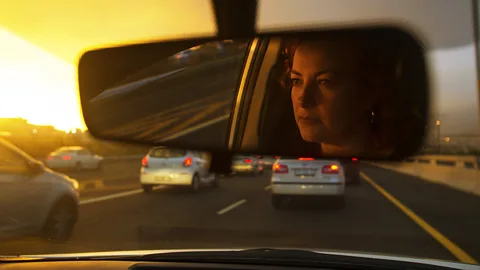 Getty Images
Getty ImagesElsewhere, intelligent infrastructure is helping transport networks to become more connected. Siemens Mobility are working with cities and municipalities around the world to identify patterns of movement in an attempt to identify ways of improving experience for everyone on the road.
“There are real world projects around the globe and the applications are continuously expanding,” says Markus Schlitt, head of intelligent traffic systems at the company.
“In future cities, traffic will be so complex that without artificial Intelligence (AI) it will be virtual gridlock,” says Schlitt. “By utilising the data, we’re able identify patterns that would not have been seen without AI. Through continuous learning, we’re able to constantly update the traffic patterns and thus traffic flow. This results in less waiting time and fewer emissions.”
In Hagen, , they are using artificial intelligence to optimise traffic light control and reduce the waiting time at an intersection. Simulations suggest it can decrease waiting times at lights by up to 47% compared to a traditional pre-timed signal plan.
But it’s not just motorists that are benefiting from the use of AI. Siemens Mobility are operating a fleet of 1,400 electric bikes in Lisbon, Portugal,, using machine learning to analyse various data sources like the weather to predict the future demand at each of the 140 bike-sharing stations. This allows them to ensure the availability of bikes and spaces in charging docks for those returning bikes. The predictions are used along with recent traffic information to help bike collection teams restock docking stations and provide optimal routing for service technicians who maintain the bikes.
“This not only reduces operational running costs, it also increases the end-customers’ experience,” says Schlitt. “So when you need to get around in Lisbon, you can be sure that there is always an e-bike available for you at the stations.”
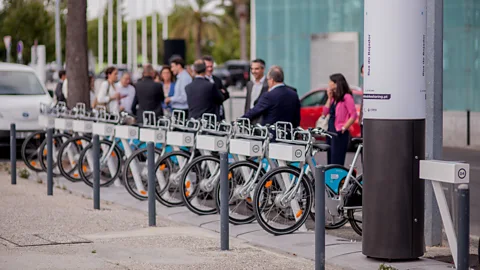 Siemens Mobility
Siemens MobilityAs brilliant as the technology is, we can’t rely on it solely. Mischa Dohler, from the department of informatics at King’s College London and co-founder of traffic monitoring technology company Worldsensing, has been trialling AI and machine learning in Bogota, Colombia. He says the technology has already produced great results, by using road signals and signs to reroute traffic when there is an accident, reduce traffic jams, and lessen the time motorists spend seeking parking spaces.
But he says that while AI is helping to make this sort adaptive transport network possible, the human element is important too. He calls this “explainable AI planning”. It is “so important because it takes intelligent decisions autonomously but is also understandable”, allowing humans to take decisions alongside the AI or adapt if something goes wrong. As well as being intellectually and technically capable, motorists themselves will have to be open to the idea of their traffic systems being controlled by computers.
“When cities rely on algorithms to enact policy, that policy becomes obfuscated by computation,” says Jed Carter, editor of online technology magazine Moving World. “It becomes even harder for citizens to understand why they’ve been re-routed, photographed or detained when the reasons for those actions are buried in computer code.”
But deploying smart technologies onto the roads will do more than simply prevent traffic jams. Mark Nicholson, from Vivacity Labs, who ran a UK Government backed project deploying intelligent traffic light signals in Milton Keynes, England, says that newer technologies have a lot of other benefits. Cost is one – as technology takes over more of the heavy lifting of traffic management, it will require less human intervention on mundane tasks like watching traffic cameras.
Automated systems are also getting better at differentiating between large numbers of road s, so can prioritise cyclists, buses or emergency vehicles for example, which can improve safety. Keeping traffic flowing can also reduce energy consumption caused by idling vehicles when stationary and improves air quality. It can help to cut engine emissions and so help to reduce impacts on the environment. It can make parking easier and frees up time for motorists to be more productive.
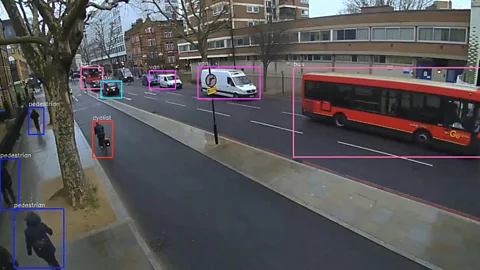 Vivacity Labs
Vivacity Labs“We want to automate and let the humans focus on what is important or more long term,” says Nicholson. “(Things) like choosing whether air quality is poor enough to prioritise HGVs to make sure they don’t need to stop next to a school, planning where to put a new by, as well as immediate issues such as choosing how to reroute traffic around a crash.”
Nicholson says that the real benefit of technology is the way that it frees up humans to do important higher level work. By automating the tedious, time consuming day-to-day running of the transport networks means humans working alongside the machines can focus on what they are best at – adapting to situations that require adaptive thinking and creative solutions.
The results from the Milton Keynes project are promising. City-wide intelligent cameras capable of identifying and classifying all vehicles and road s allowed for accurate, highly localised data around the city, giving planners and authorities insight into where and when roads get busy, the expected routes that motorists might take, and where parking spaces are likely to be available. Vivacity installed 411 of its smart traffic cameras at the major junctions in Milton Keynes, totalling 104 junctions and 812 carriageways. As well as counting and classifying road s, the sensors can measure time it takes for vehicles to travel between junctions and provide live photos to help with the development of future planning.
Vivacity feed the data into a machine learning model that learns typical daily patterns and combines this with how the traffic responds to transient changes in the road network. It evolves and adapts over time, improving its predictive power and minimising the amount of human intervention required. It provides historical and live data, and predicts traffic flows for the day.
The system is already predicting traffic conditions 15 minutes in advance with 89% accuracy compared to what happens in reality.
"It is not only helping citizens see parking space availability in real time today, but also lays the foundations for future connected & autonomous transport technologies in Milton Keynes,” says Nicholson.
What seems to be clear is that giving AI the green light on our roads could keep us all moving forward. “This is just the beginning – we haven’t even fully harnessed the capabilities and benefits of AI,” adds Markus Schlitt, from Seimens Mobility.
If you liked this story, sign up for the weekly bbc.com features newsletter, called “If You Only Read 6 Things This Week”. A handpicked selection of stories from BBC Future, Culture, Capital, and Travel, delivered to your inbox every Friday.
